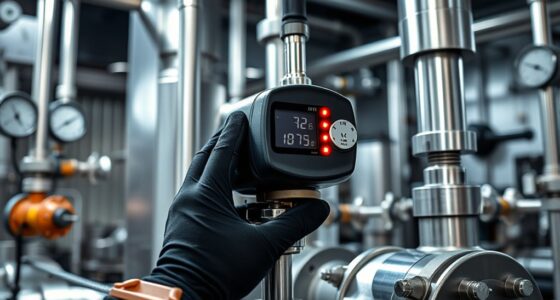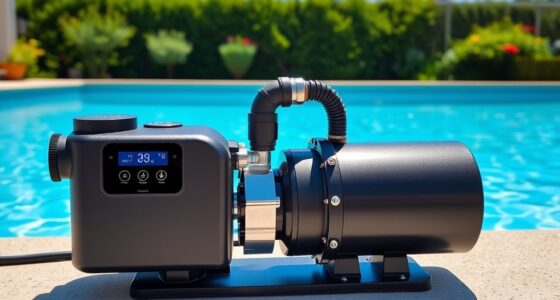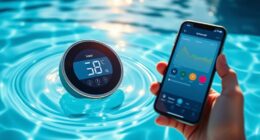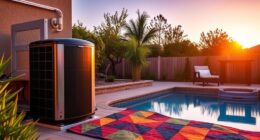Choosing the right pool filter depends on your needs and preferences. Sand filters are simple, low-cost, and require minimal maintenance but trap larger debris. Cartridge filters offer finer filtration and are easier to clean with rinsing, while DE filters provide the clearest water by trapping microscopic particles, though they need more upkeep. Each type has its pros and cons—exploring further can help you find the perfect fit for your pool.
Key Takeaways
- Sand filters are cost-effective, low-maintenance, and trap debris down to 20-40 microns, suitable for basic filtration needs.
- Cartridge filters offer finer filtration (10-15 microns), are easier to clean, and require replacement every 1-2 years.
- DE filters deliver the highest efficiency, capturing particles as small as 2-5 microns for crystal-clear water.
- Maintenance varies: sand filters need backwashing, cartridge filters need rinsing or replacing, and DE filters require backwashing and DE powder reapplication.
- The best choice depends on pool size, desired water clarity, and willingness for maintenance effort.
Overview of Pool Filter Types
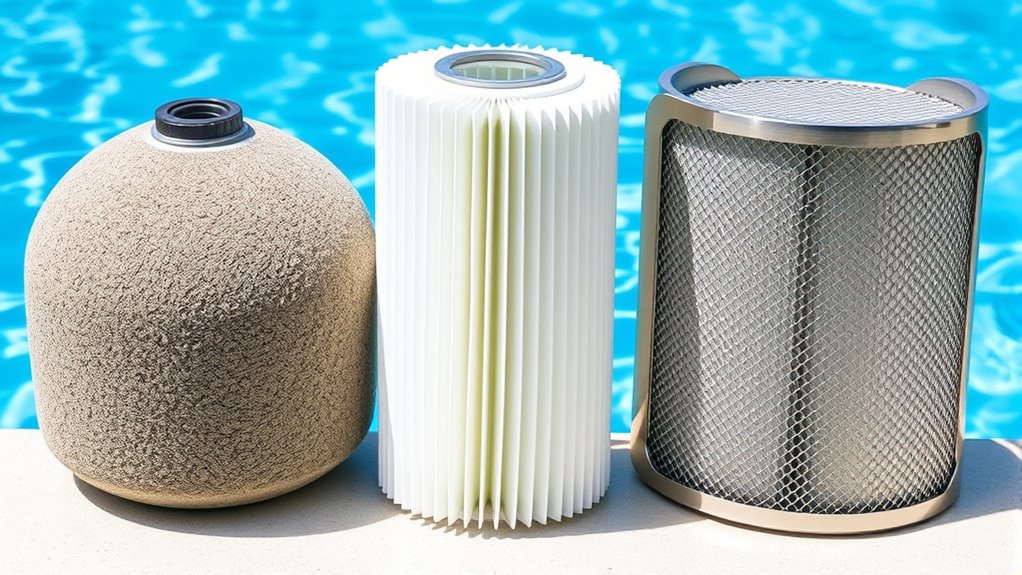
Are you wondering which type of pool filter is best for your needs? There are three main options: sand, cartridge, and DE filters. Sand filters are popular for their simplicity and low maintenance, using specialized sand to trap dirt and debris. Cartridge filters feature a replaceable filter element that captures smaller particles, offering easier cleaning and better water clarity. DE filters (diatomaceous earth) provide the highest filtration efficiency by using a fine powder to trap tiny contaminants, making your water crystal clear. Each type has its strengths: sand filters are cost-effective, cartridge filters are convenient, and DE filters deliver superior filtration. Your choice depends on your pool size, budget, and how much maintenance you’re willing to do. Additionally, advancements in automation technology are increasingly influencing pool maintenance practices, making some filtering systems more efficient and easier to manage. Understanding the filtration process can help you select the most suitable system for optimal water quality. Regular maintenance and proper understanding of each system’s filtering mechanism can extend the lifespan of your equipment and improve overall water clarity. Moreover, knowing how personality traits influence maintenance habits can help you choose a system that aligns with your lifestyle and preferences. Considering the cost of maintenance over time can also guide you toward the most economical choice for your situation.
How Sand Filters Work

Have you ever wondered how sand filters keep your pool water clean? Sand filters use a large tank filled with specially graded sand as the filtering medium. When you turn on the pump, water is drawn into the tank and forced through the sand bed. As water passes through, debris like dirt, algae, and small particles get trapped in the tiny spaces between sand grains. Clean water then flows out of the filter and back into your pool. Over time, debris accumulates, causing the water flow to slow down. When this happens, you need to backwash the filter—flushing out the trapped dirt and restoring filter efficiency. Regular maintenance and understanding filtration efficiency can help prolong the life of your sand filter and ensure optimal water quality. Proper filter media choice and replacement schedule are essential for maintaining the best filtration performance. Additionally, selecting the appropriate filter type can influence the ease of maintenance and overall effectiveness of your pool’s filtration system. To optimize performance, it is also important to monitor water chemistry, which can affect filter longevity and efficiency. Being aware of filter system components, such as the multiport valve, can further improve your maintenance routine.
The Mechanics of Cartridge Filters

Understanding how cartridge filters work helps you keep your pool clean and clear. You’ll learn about the filtration process and how to maintain or replace the cartridges when needed. Proper knowledge guarantees your filter functions efficiently and lasts longer. Additionally, regular maintenance can be optimized by understanding automation’s role in business intelligence, which enables real-time monitoring and diagnostics of your pool’s filtration system. Recognizing filter media types can further enhance maintenance strategies and improve overall system performance. Being aware of filter replacement intervals ensures you replace cartridges at the optimal time to maintain water clarity and system efficiency. Incorporating technological advancements into your routine can also streamline cleaning and extend filter lifespan.
Filtration Process Overview
Cartridge filters work by trapping particles as water passes through their pleated fabric, effectively removing debris and impurities from the pool water. As the pump circulates water, it flows through the filter’s pleats, which increase surface area for filtration. Larger debris, like leaves and dirt, are caught on the surface, while smaller particles, such as algae and bacteria, get trapped within the fabric. The filtration process relies on the fabric’s fine pores to screen out contaminants, keeping the water clear and clean. Water then exits the filter and returns to your pool. This process is continuous, ensuring consistent water quality. Over time, the trapped debris accumulates, gradually reducing flow and filtration efficiency, which is why regular cleaning or replacement is necessary. Proper maintenance of the filter, including routine cleaning, helps maintain the filtration efficiency and extends the lifespan of the cartridge. Additionally, understanding the filter medium used in cartridge filters can help optimize their performance and longevity. Regular monitoring of the pressure gauge can also indicate when cleaning or replacing the filter is needed to maintain optimal operation.
Maintenance and Replacement
Regular maintenance of your cartridge filter is essential to guarantee it continues to operate effectively. You should clean the filter regularly, typically once every few weeks, by removing the cartridge and rinsing it with a garden hose to remove debris and dirt. If the filter becomes heavily soiled or clogged, it’s time to replace the cartridge entirely—usually every 1-2 years, depending on usage and water quality. Always turn off the pump before servicing to prevent damage or injury. When replacing, ensure you use the correct cartridge size and follow the manufacturer’s instructions for installation. Proper filter maintenance and replacing it when necessary helps maintain clear, healthy water and prolongs the lifespan of your filtration system. Staying attentive to tuning practices can optimize your system’s performance and efficiency.
The Functionality of Diatomaceous Earth (DE) Filters

Diatomaceous earth filters excel at capturing tiny particles, keeping your pool crystal clear. They have a large filter surface area, which improves their efficiency and extends cleaning periods. When it’s time to clean, the backwashing process helps restore their filtering power quickly. Additionally, using high-quality filtration technology ensures optimal removal of airborne contaminants and maintains water clarity. Modern DE filters also incorporate noise reduction technology, making operation quieter and more comfortable for homeowners.
Fine Particle Removal
Because of their microscopic structure, diatomaceous earth (DE) filters excel at removing fine particles from pool water, ensuring a clearer and healthier swimming environment. The filter’s tiny pores trap particles as small as 2 to 5 microns, including algae, dirt, and bacteria. This high level of filtration helps prevent cloudiness and reduces the risk of skin and eye irritation. When water passes through the DE layer, even the smallest contaminants are captured, resulting in sparkling clear water. Regular backwashing or replacement maintains this filtration efficiency. Because DE filters are so effective at capturing fine debris, they’re ideal for maintaining pristine water quality, especially if you swim frequently or want to minimize chemical use. Their ability to remove microscopic particles makes DE filters a top choice for thorough pool cleaning.
Filter Surface Area
Have you ever wondered how DE filters achieve such thorough cleaning? It all comes down to their massive surface area. DE filters use a layer of diatomaceous earth, which creates an incredibly fine and extensive mesh. This thin layer covers the filter grids, increasing the surface area exponentially compared to sand or cartridge filters. The larger surface area allows DE filters to trap tiny particles more effectively, improving water clarity and quality. Because the DE layer is so extensive, it can capture more debris without clogging quickly. This means you get better filtration and longer periods between cleanings. The extensive surface area is the key to DE filters’ superior ability to remove even the smallest contaminants from your pool water.
Backwashing Process
Ever wonder how DE filters maintain their efficiency? When the filter becomes dirty, you need to perform a backwash to clear out the trapped debris and excess DE powder. Unlike sand filters, DE filters require a special backwashing process that involves reversing the flow of water through the filter. You’ll turn the valve to the backwash setting, which loosens and flushes out dirt, debris, and used DE. Afterward, you’ll need to add fresh DE powder to the skimmer to recharge the filter’s filtering capacity. This process keeps your filter functioning ideally, ensuring clear water and proper filtration. Regular backwashing prevents clogging, maintains flow rate, and extends the life of your DE filter, keeping your pool water clean and healthy.
Comparing Filtration Efficiency and Clarity

When comparing pool filters, understanding their filtration efficiency and the clarity they provide is essential. Sand filters typically trap particles down to about 20-40 microns, so your water might appear clear but still contain tiny debris. Cartridge filters excel here, capturing particles as small as 10-15 microns, resulting in noticeably clearer water and better removal of contaminants. Diatomaceous Earth (DE) filters offer the highest efficiency, filtering particles as small as 2-5 microns, delivering crystal-clear water and superior clarity. If you prioritize pristine water with minimal cloudiness, DE filters are your best choice. However, consider your pool size and typical debris levels, as these factors influence the actual clarity you’ll achieve with each type.
Maintenance and Upkeep Considerations
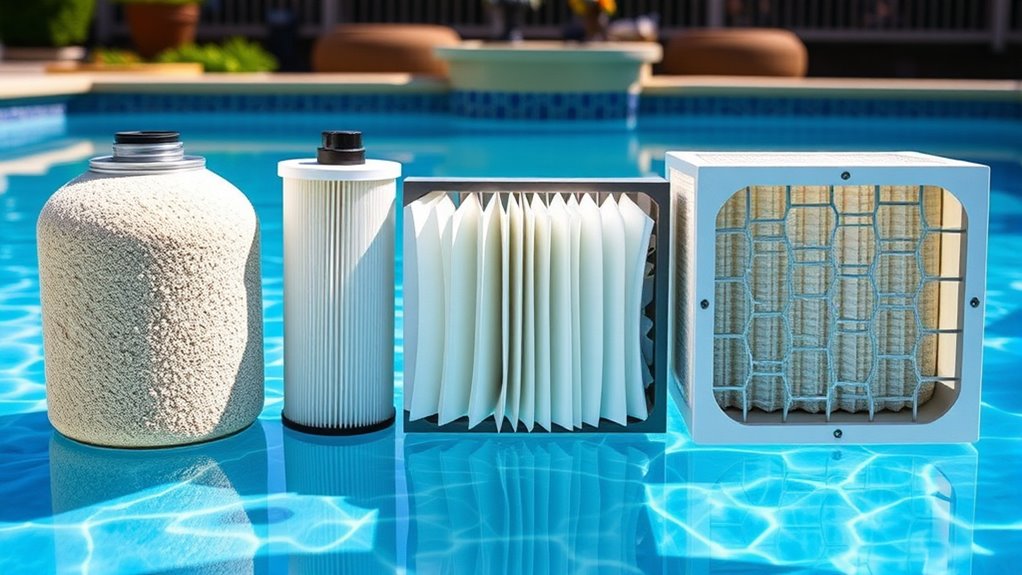
Maintaining your pool filter is essential to guarantee it operates efficiently and lasts longer. Regular cleaning prevents debris buildup that can clog the system and reduce filtration performance. For sand filters, backwashing every few weeks is necessary to flush out trapped dirt and oils. Cartridge filters require removing the element and rinsing it thoroughly with a hose, and replacing it every couple of seasons. D.E. filters need periodic backwashing and reapplication of diatomaceous earth to keep efficiency high. Always inspect the pressure gauge; a rise indicates it’s time for cleaning. Keep an eye on O-rings and seals for signs of wear, replacing them promptly. Proper maintenance not only preserves water clarity but also minimizes equipment repairs and downtime.
Cost and Longevity of Different Filters

Choosing the right pool filter involves balancing initial costs with long-term durability. Sand filters are usually the most affordable upfront, but they need replacement every 5-7 years, adding to maintenance costs. Cartridge filters have higher initial costs but last about 3-5 years and require less water and chemical use during cleaning. DE filters are the most expensive initially but last 4-8 years and provide superior filtration, reducing long-term maintenance. Here’s a quick comparison:
| Filter Type | Cost Range (Initial) | Longevity | Maintenance Frequency | Replacement Cost |
|---|---|---|---|---|
| Sand | $150 – $300 | 5-7 years | Low | Low |
| Cartridge | $200 – $400 | 3-5 years | Moderate | Moderate |
| DE | $300 – $600 | 4-8 years | Low to moderate | Higher |
Choosing the Best Filter for Your Pool Needs

Selecting the right pool filter depends on your specific needs and priorities, whether that’s budget, ease of maintenance, or water quality. If you want a low-cost option, a sand filter might suit you, as it’s durable and simple to operate. For clearer water and less frequent cleaning, a cartridge filter could be ideal, though it may require more regular cartridge replacements. If you prioritize the highest water clarity and filtration efficiency, a DE filter is your best choice, but it comes with higher initial costs and more maintenance. Consider your pool size, local climate, and how much time you’re willing to dedicate to upkeep. Matching your priorities with each filter’s strengths will help you make an informed decision and ensure your pool stays clean and inviting.
Frequently Asked Questions
Which Pool Filter Type Is Best for Large or Small Pools?
When choosing a pool filter, consider your pool size. For large pools, you want a filter that handles high flow rates and offers efficient cleaning, like DE filters, or multi-port sand filters for easy maintenance. Small pools benefit from cartridge filters, which are compact and simple to clean. Ultimately, assess your pool’s size, budget, and maintenance preferences to pick the best filter type for your needs.
How Often Should I Replace or Clean My Pool Filter?
You should clean or replace your pool filter regularly to keep your water clear. For cartridge filters, clean them every 1-2 months, and replace every 1-3 years. Sand filters need backwashing every 4-6 weeks, with the sand replaced every 5-7 years. DE filters require backwashing every 4-6 weeks, and the DE powder should be replenished after each backwash. Regular maintenance keeps your pool sparkling.
Can I Use Multiple Filter Types Simultaneously?
Using multiple filter types at the same time isn’t recommended because they work differently and can interfere with each other’s effectiveness. For example, a sand filter and a cartridge filter have different pore sizes and cleaning methods. It’s better to choose one type based on your pool’s needs. Mixing filters can cause damage or reduce filtration efficiency, so stick with a single filter system for ideal results.
Are There Specific Detergents or Chemicals Compatible With Each Filter?
You ask if specific detergents or chemicals work with each filter type. Generally, pool chemicals like chlorine and algaecides are safe for all filters, but avoid harsh detergents or cleaners not designed for pools, as they can damage the filter media. Always follow manufacturer instructions, and if you need to clean or maintain your filter, use products recommended for your specific filter type to guarantee longevity and proper function.
How Do Filter Types Impact Pool Water Chemistry and Chemical Balance?
You should understand that your filter type influences how often you need to test and balance your pool water. Sand filters generally require less maintenance but may trap fewer particles, affecting clarity. Cartridge filters improve water clarity but need regular cleaning. DE filters offer the best filtration, but they can impact chemical levels if not cleaned properly. Regular testing and balancing make certain your water stays safe and clear, regardless of filter type.
Conclusion
Ultimately, choosing the right pool filter is like selecting the perfect lens for a clear view—each type offers a unique perspective. Sand filters provide simplicity, cartridge filters deliver convenience, and DE filters offer unmatched clarity. Consider your pool’s needs, maintenance willingness, and budget. Remember, the ideal filter doesn’t just clean your pool—it transforms it into a sparkling oasis, reminding you that clarity isn’t just about water but about the quality of your enjoyment.



